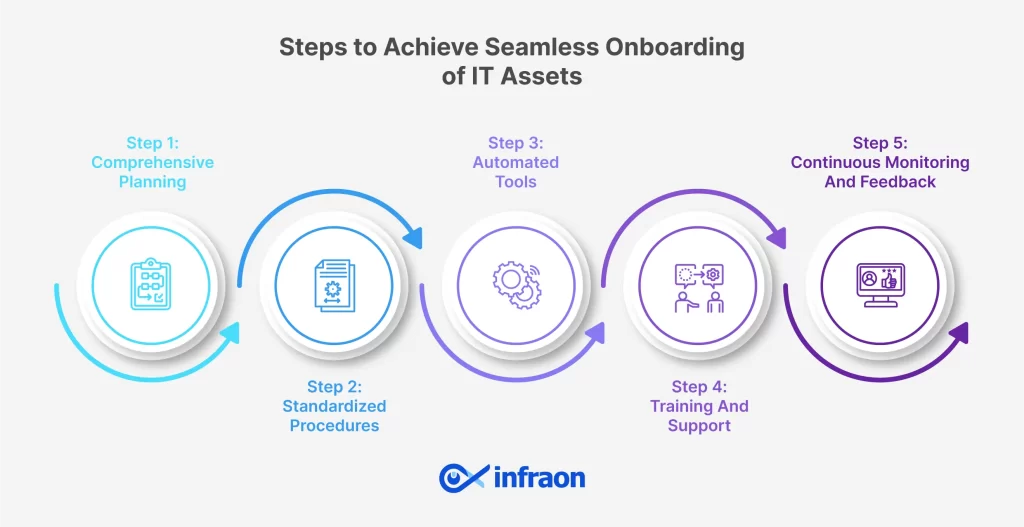In today’s banking environment, a smooth IT Assets Onboarding process is extremely important. It minimizes disruptions, accelerates the deployment of new technologies, and ensures that all systems function cohesively. It is important in the banking sector, where even minor delays or errors can have a huge impact.
Related blog: Why AI-enabled ITOPs is critical for smarter banking operations
First, let’s look at the challenges involved.
Major Challenges of IT Asset Onboarding for Banks
Complex integration with legacy systems
One of the biggest challenges is integrating new IT assets with existing legacy systems. Banks often have long-standing IT infrastructures that are deeply embedded in their operations. Ensuring that new assets can seamlessly communicate and operate with these older systems requires careful planning and often custom integration solutions. Failure to achieve smooth integration can lead to operational disruptions and inefficiencies.
Inefficient data migration
This process must be conducted with precision to ensure data integrity and security. Banks handle vast amounts of sensitive information, so any errors or data loss during migration can have severe repercussions, including compliance issues and loss of customer trust. Effective data migration strategies and tools are essential to mitigate these risks.
Unmet regulatory compliance
Banks operate in regulated environments. Hence, new IT assets onboarding must comply with a myriad of regulations and standards. Ensuring that new systems meet all compliance requirements can be daunting, requiring extensive documentation, testing, and validation. Any oversight can result in regulatory penalties and damage to the bank’s reputation.
Cybersecurity concerns
The introduction of new IT assets can expose banks to new cybersecurity risks. Ensuring that these assets are secure from the moment they are deployed is critical. Some of the ways include implementing security protocols like encryption, access controls, and vulnerability assessments. Cybersecurity is a constant concern, and new assets must be protected against threats from the outset.
Training and change management issues
Introducing new IT assets often requires changes to workflows and processes. Making sure that staff are comfortable with the new systems is a challenge. Effective change management strategies are needed to support employees through the transition, minimizing resistance and ensuring that they can quickly become proficient in technology.
Steps to Achieve Seamless Onboarding of IT Assets

1) Comprehensive planning
Before onboarding new IT assets, banks should develop a detailed plan. It includes defining objectives, identifying required resources, and outlining steps for integration. Planning helps in anticipating potential challenges and preparing solutions in advance.
- Objectives: Clearly define the goals of the IT asset onboarding process
- Resources: Identify necessary hardware, software, and personnel
- Timeline: Establish a realistic timeline for the IT asset onboarding process
2) Standardized procedures
Implementing standardized procedures for IT asset onboarding ensures consistency and reduces the risk of errors. These procedures should cover all aspects of the onboarding process, from initial setup to final testing.
- Setup guidelines: Detailed instructions for configuring new IT assets
- Integration steps: Procedures for connecting new assets with existing systems
- Testing protocols: Steps to verify that new assets are functioning correctly
3) Automated tools
Using automated tools can streamline the IT asset onboarding process. Automation helps reduce manual efforts, speeding up deployment and ensuring accuracy. Some of the examples of automated tools are:
- Configuration management: Tools to automatically configure new IT assets according to predefined settings
- Deployment software: Applications that automate the installation and integration of new systems
- Monitoring tools: Software to continuously monitor the performance of new assets during the onboarding phase
4) Training and support
As earlier mentioned, ensuring that personnel are well-versed in the new systems and the IT asset onboarding procedures enhances the overall process. Training can include:
- Workshops: Conduct workshops to train staff on new IT assets and onboarding procedures
- Documentation: Provide comprehensive documentation to guide staff through the onboarding process
- Support channels: Establish support channels for addressing any issues that arise during onboarding
5) Continuous monitoring and feedback
After IT asset onboarding, continuous monitoring of new IT assets ensures they are performing as expected. Collecting feedback from users helps in identifying any issues early and making necessary adjustments. Some of the strategies are:
- Performance metrics: Track key performance indicators to ensure new assets are meeting expectations.
- User feedback: Gather input from staff and users to identify any problems or areas for improvement.
- Regular reviews: Conduct regular reviews of the onboarding process to refine and improve it over time.
Key Benefits of Seamless IT Asset Onboarding for Banks
Reduced downtime
Seamless IT asset onboarding plays a critical role in minimizing downtime. By ensuring that new hardware, software, and systems are operational swiftly, banks can avoid the costly interruptions that typically accompany IT asset deployment. Quick setup and integration mean that banking operations can continue without huge delays, maintaining service availability and customer satisfaction.
Enhanced integration
Enhanced integration is a key benefit of seamless IT asset onboarding. When new systems and technologies are introduced, they must work harmoniously with the existing infrastructure to provide a consistent and reliable user experience.
A well-planned onboarding process ensures that all components, from servers to software applications, are configured to operate together smoothly. Such a unified IT environment helps prevent compatibility issues, reduces the risk of errors, and simplifies the management of IT resources, leading to more stable banking operations.
Improved performance
Ensuring that new IT assets are optimized from the start is vital for improved performance. Seamless onboarding includes thorough testing and fine-tuning of new assets to ensure they operate at peak efficiency from day one. This proactive approach helps identify and resolve potential performance bottlenecks early, ensuring that the new systems deliver the expected benefits without unnecessary delays.
Enhanced performance translates to faster transaction processing, better customer service, and more robust support for critical banking functions, ultimately contributing to the bank’s overall success and competitiveness.
Increased staff productivity
Seamless onboarding of IT assets boosts staff productivity. When new systems are integrated without disruptions, employees can quickly adapt to and start using the latest technologies. This streamlined transition reduces the learning curve and minimizes downtime, allowing staff to focus on their core responsibilities without being hampered by technical issues or lengthy setup processes.
Additionally, intuitive and well-integrated IT assets enable employees to work smarter, as they can leverage enhanced functionalities and improved system performance. The result is a more productive workforce that can better meet the demands of customers and the operational goals of the bank.
Quick and reliable onboarding of IT assets is crucial for maintaining smooth banking operations. It ensures that new assets are seamlessly integrated, reducing downtime and enhancing system performance, ultimately providing better services to customers.
Related blog: How integrated ITOPs can enhance security and compliance in banking



















